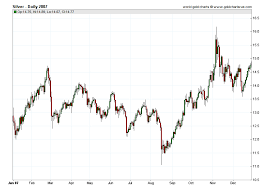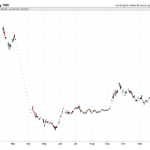Silver prices in 2007 experienced a range of fluctuations and trends that were influenced by various market forces. This article aims to explore the daily price data, LBMA silver price fix history, and market commentaries to understand the factors that drove the precious metal’s value during this period.
By analyzing the data, we can gain insights into the dynamics of the silver market in 2007, which can be useful for investors, traders, and anyone interested in the precious metals industry.
The LBMA Silver Price Auction, which was held around noon locally, was the most widely quoted benchmark in the industry. During 2007, silver prices ranged from $11.69 oz to $15.82 oz, with the highest price occurring on November 8, 2007, and the lowest price occurring on August 17, 2007.
The price fluctuations and trends during this period were influenced by various factors, including global economic conditions, geopolitical events, and supply and demand dynamics. This article will delve into these factors to provide a comprehensive analysis of silver prices in 2007.
Price Data Overview
The pre-existing knowledge provides an overview of the prices of silver in 2007, offering a historical context for the fluctuations and trends observed during that period. Daily prices for each month were recorded, and the LBMA Silver Price Auction held around 12:00 PM noon locally was used to arrive at composite prices. Additionally, Forex prices, which are the most widely quoted in the precious metals industry and trade continuously 24 hours a day, were monitored.
It is worth noting that the prices fluctuate daily and generally increase over time, with the highest price of $15.82 oz being recorded on November 8, 2007, and the lowest price of $11.69 oz being recorded on August 17, 2007.
It is interesting to compare the prices of silver in 2007 to current prices, as it provides perspective on the fluctuations and trends observed. As of July 2021, the price of silver is hovering around $26.00 oz, which is significantly higher than the highest price recorded in 2007. However, it is important to note that prices are subject to various factors, including supply and demand, economic conditions, and geopolitical events, among others. Therefore, it is difficult to predict future trends in silver prices with certainty, and any investment decisions should be made with caution and after careful analysis of market conditions.
Factors Affecting Prices
Various factors have an impact on the value of silver, such as changes in global economic conditions and geopolitical events, as evidenced by the sudden increase in silver prices in 2007 following the subprime mortgage crisis in the United States.
Silver is a commodity that is both a store of value and an industrial metal, meaning that its price is influenced by both investment demand and industrial demand. As a result, shifts in global economic conditions can have a significant impact on silver prices, as they affect both the supply and demand for the metal.
One factor that affects the supply and demand of silver is the level of industrial production, particularly in emerging markets. Because silver is used in a variety of industrial applications, such as electronics and solar panels, shifts in global manufacturing activity can have a significant impact on demand for the metal.
Additionally, changes in investor sentiment can influence the demand for silver as a safe-haven asset, particularly during times of economic uncertainty. As such, investors closely monitor global economic conditions and geopolitical events when assessing the potential impact on silver prices.
Significant Price Changes
Significant shifts in global economic conditions and geopolitical events can have a substantial impact on the demand for and supply of precious metals, including silver. In 2007, there were several significant price changes that reflected the impact of such events.
For instance, the highest price of silver was recorded on November 8, 2007, at $15.82 oz. This price increase was mainly due to a weak US dollar and geopolitical tensions between the US and Iran, which led to increased investor demand for safe-haven assets such as silver.
Market analysis indicates that investors often turn to precious metals such as silver during times of economic and political uncertainty. However, investment strategies must be carefully considered, as prices fluctuate daily and are influenced by a variety of factors.
Using online price data, market commentaries, and opinions for speculative purposes is not advised. Instead, investors should focus on asset preservation and prudent allocation purposes when purchasing physical precious metal bullion products.
Overall, understanding the impact of significant events on silver prices can help investors make informed decisions regarding their investment strategies.
Frequently Asked Questions
What is the current price of silver?
Silver market analysis shows that as of [insert date], the current price of silver is [insert price] per ounce. Investors interested in investing in silver futures should consider the daily fluctuations and trends in the market to make informed decisions.
How does the price of silver compare to other precious metals?
Silver vs Gold: A Comparison reveals that gold is historically more valuable and less volatile, while silver is more affordable and has greater industrial applications. Silver’s price is influenced by both investment and industrial demand.
What is the forecast for silver prices in the future?
Silver prices are influenced by silver demand trends and global economic changes. The forecast for silver prices is uncertain as it is subject to unpredictable market fluctuations. Data-driven analysis can provide insights, but caution should be exercised in making speculative predictions.
How does political instability affect the price of silver?
Political instability can cause investors to seek safe-haven assets such as silver, driving up demand and prices. Economic factors, such as inflation and interest rates, can also impact silver prices. Silver prices in 2007 fluctuated due to a range of factors, including supply and demand, global economic conditions, and geopolitical events.
What is the process for buying physical silver bullion products?
Silver bullion dealers are trusted sources for purchasing physical silver bullion products, such as coins, bars, and rounds. Buyers can choose from various types of silver products, including government-minted or privately minted options. It is important to do thorough research and compare prices before making a purchase.





